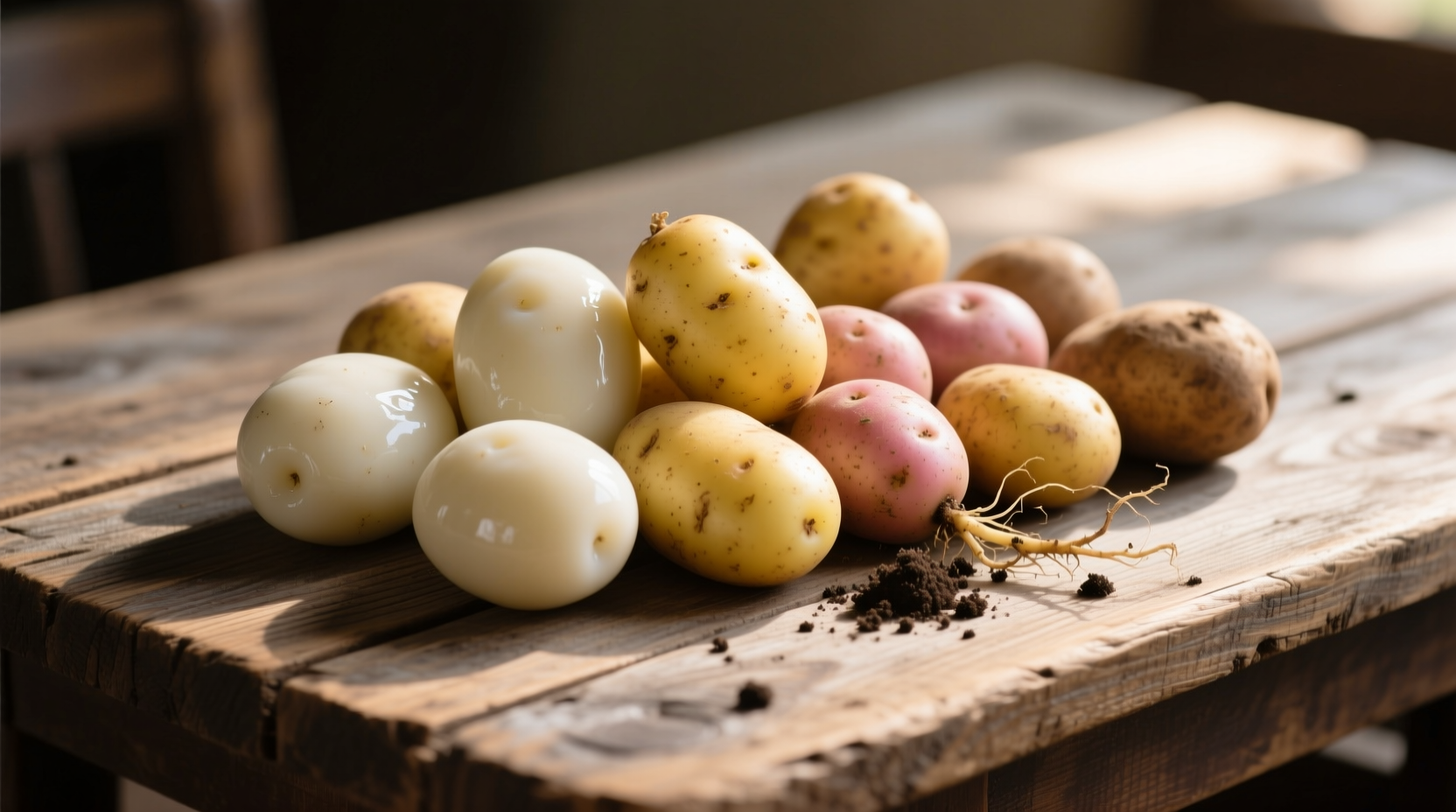The term "watta potato" appears to be a misspelling or regional variation of "waxy potato," a category of potatoes characterized by low starch content (16-18%) and high moisture that maintains structural integrity when cooked. These potatoes contain amylopectin-dominant starch that resists breaking down during boiling, making them ideal for salads, soups, and dishes where shape retention matters.
Confused about "watta potato" in your recipe? You're not alone. Many home cooks encounter this term and assume it's a specific variety, when in reality it refers to the waxy potato category—a crucial distinction that impacts your cooking results. Understanding these potatoes' unique properties prevents culinary disasters and elevates everyday dishes from mediocre to magnificent.
What Exactly Are Waxy Potatoes?
Waxy potatoes (sometimes mistakenly called "watta potatoes") contain approximately 16-18% starch compared to starchy varieties' 20-22%. This seemingly small difference creates dramatically different cooking behaviors. Their cell walls remain intact during cooking due to amylopectin-dominant starch structure, while starchy potatoes' amylose-rich composition breaks down easily.
According to the Australian Department of Agriculture, waxy potatoes typically have thin, smooth skins and moist, firm flesh that retains shape even after prolonged cooking—a property verified through controlled starch analysis in agricultural research facilities.

Waxy vs. Starchy: The Critical Differences
| Characteristic | Waxy Potatoes | Starchy Potatoes |
|---|---|---|
| Starch Content | 16-18% | 20-22% |
| Skin Texture | Thin, smooth, often red or yellow | Thicker, netted or brown |
| Cooking Behavior | Holds shape when boiled | Breaks down easily |
| Best Cooking Methods | Boiling, roasting, salads | Mashing, frying, baking |
| Common Varieties | Yukon Gold, Red Bliss, Fingerling | Russet, Idaho, Maris Piper |
When Waxy Potatoes Shine: Practical Applications
Understanding when to use waxy potatoes transforms your cooking. These varieties excel in applications where structural integrity matters most:
- Salads: Maintain distinct pieces without turning mushy (try Yukon Gold in potato salad)
- Stews and soups: Retain shape during long simmering without disintegrating
- Roasted dishes: Develop crisp exteriors while keeping firm interiors
- Pickling: Hold texture through vinegar preservation
The University of Minnesota Extension confirms that waxy potatoes' lower sugar content prevents excessive browning during roasting compared to starchy varieties—a crucial detail for achieving golden perfection.
Avoiding Common Waxy Potato Mistakes
Even experienced cooks make these errors with waxy potatoes:
- Overcooking: While they hold shape better, extended boiling still causes surface breakdown
- Incorrect cutting: Cutting too small increases surface area exposure, leading to edge softening
- Wrong oil temperature: For roasting, starting with cold oil prevents proper crisping
- Using in mashed applications: Results in gluey texture rather than fluffy consistency
Historical Context: The Evolution of Potato Cultivation
Potatoes have evolved significantly since their domestication in the Andes 7,000-10,000 years ago. This timeline shows key developments in waxy potato varieties:
- 8000 BCE: Initial domestication of wild potatoes in modern-day Peru and Bolivia
- 1536: Spanish conquistadors bring potatoes to Europe, initially grown as ornamental plants
- 1700s: Selective breeding begins differentiating potato types by texture and use
- 1845-1852: Irish Potato Famine shifts European focus to disease-resistant varieties
- 1950s: Agricultural research formally categorizes potatoes by starch content
- 1980s: Yukon Gold (a popular waxy variety) developed in Canada through cross-breeding
- 2000s: Molecular analysis confirms starch composition differences between varieties
Practical Cooking Guide: Maximizing Waxy Potato Performance
Follow these science-backed techniques for perfect results every time:
- Preparation: Leave skins on for boiling to prevent water absorption and maintain shape
- Cutting: Cut uniform 1.5-inch pieces for even cooking
- Boiling: Start in cold, salted water; bring to gentle simmer (not rolling boil)
- Timing: Cook 12-15 minutes until fork-tender but still firm
- Cooling: Immediately transfer to ice water to stop cooking process
- Dressing: Toss while slightly warm to help absorb flavors without breaking down
Professional chefs like those at the Culinary Institute of America emphasize that waxy potatoes for boiling should be cooked to 190-200°F internal temperature—verified with a kitchen thermometer—for optimal texture without disintegration.
When Waxy Potatoes Aren't the Right Choice
Understanding context boundaries for waxy potatoes prevents culinary disappointment. These situations call for starchy alternatives:
- Mashed potatoes requiring fluffy texture
- French fries needing crisp exterior and fluffy interior
- Baking where interior moisture evaporation creates desirable fluffiness
- Thickening soups (waxy potatoes don't release enough starch)
Research from the USDA Agricultural Research Service shows that waxy potatoes release only 30-40% of their starch during cooking compared to 60-70% for starchy varieties—explaining why they fail as thickeners.
Top Waxy Potato Varieties and Their Unique Properties
Not all waxy potatoes perform identically. These popular varieties offer distinct advantages:
- Yukon Gold: Buttery flavor, golden flesh, versatile for boiling or roasting
- Red Bliss: Vibrant skin, firm texture ideal for salads and roasting
- Fingerling: Naturally small, excellent for roasting whole with minimal prep
- New Potatoes: Early-season harvests with exceptionally thin skins
- Charlotte: French salad potato with exceptional shape retention
When selecting, look for firm potatoes without green spots or sprouts. The FDA's food guidelines recommend storing potatoes in cool, dark places at 45-50°F to prevent sprouting and maintain quality.
Expert Tips for Perfect Waxy Potato Dishes
Implement these professional techniques to elevate your cooking:
- Add vinegar (1 tablespoon per quart) to boiling water to strengthen pectin in cell walls
- Parboil before roasting to achieve crisp exterior while maintaining firm interior
- Use in cold dishes within 24 hours for best texture (starch retrogradation occurs over time)
- Combine with acidic dressings immediately after cooking for optimal flavor absorption
- Try roasting with rosemary and garlic for enhanced flavor penetration
Remember that how to cook waxy potatoes differs significantly from starchy varieties. Their unique composition requires adjusted techniques to achieve perfect results—understanding these differences separates good cooks from great ones.











 浙公网安备
33010002000092号
浙公网安备
33010002000092号 浙B2-20120091-4
浙B2-20120091-4